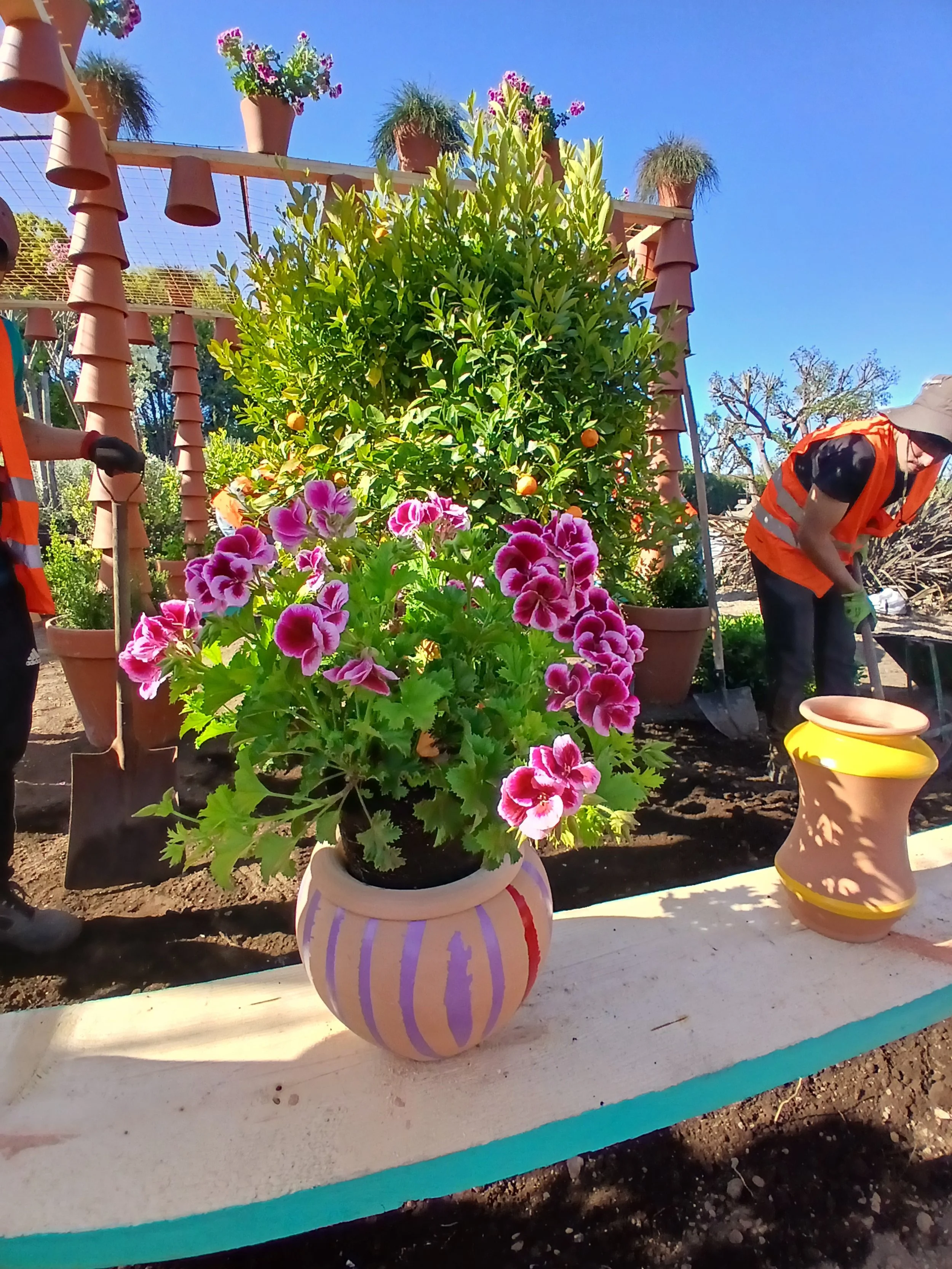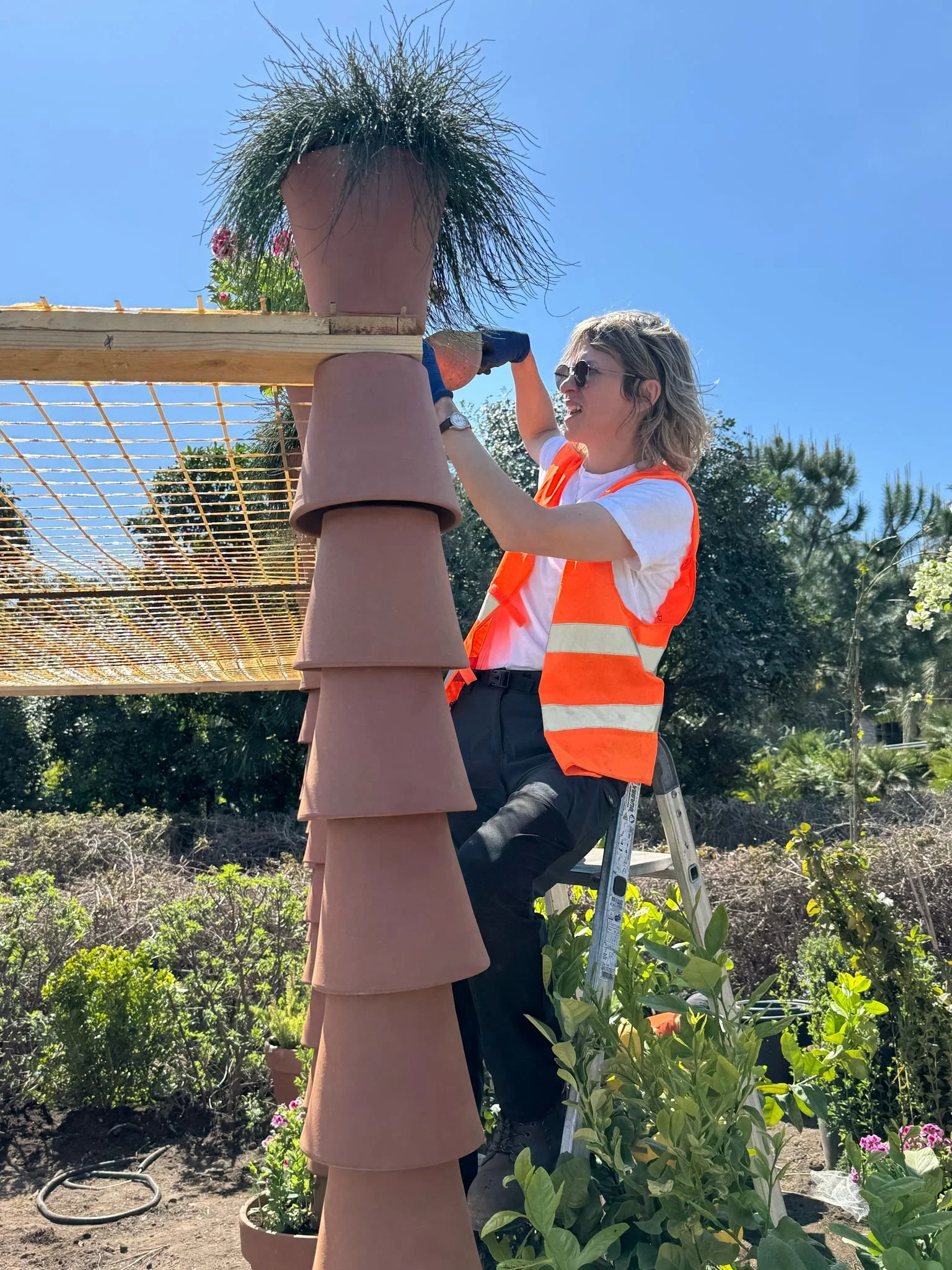WHEN STRUCTURE MEETS LIFE
DATE: April 2025
ROLE: On-site assistance during the construction of the “Patio” garden by Fernando and Marta Gamarro, as part of the Radicepura Mediterranean Garden Festival Biennale.
NARRATIVE:
A Geometric Structure
This was the second garden I helped bring to life at the Mediterranean Garden Festival. At first, I must admit, I had doubts. The rigid, rectangular shapes and the strongly defined architectural structure felt closed, almost like a cage. It seemed like a garden without breath. Yet, I was curious: I wanted to see how my perception would evolve as the project took shape.
The garden was designed by two architect siblings from Granada, Fernando and Marta Gamarro, with whom I immediately developed a warm and joyful working relationship—cheerful, open, generous.
My role was to support the designers alongside the site team. We began by laying out the plan, marking the positions of the large terracotta pots with lime. In those spots, we dug holes to set the foundations, into which we inserted circular metal profiles that would hold the vertical structure of the inverted pots all the way to the roof. Precision was critical: once the profiles were set in concrete, no adjustments could be made. To check alignment, we would line ourselves up with the row of posts: if we could only see the first one ahead, it was a success!
After several days of assembly, the columns were ready. Then we moved on to the roof, installing perimeter wooden beams. The tricky part was finding a stable technical solution to support two more levels of suspended pots. It wasn’t simple: between suggestions from festival staff, SketchUp models, and on-site discussions… we ultimately decided on two overlapping boards—a solution that was solid, effective, and widely accepted.
Meanwhile, the lightest and most creative phase arrived: painting the pots. Each one was hand-painted following the patterns proposed by the designers. It was a collective, joyful moment that brought energy and fun to the entire team.
I Couldn’t Feel It “Alive”
Until that moment, I still didn’t feel that we were creating a living landscape. The structure was fascinating, yes, but rigid, distant. I couldn’t sense it as “alive.”
Then the green arrived, and finally I began to feel the atmosphere of the Patio—the inspiration behind the project: a typical Andalusian courtyard offering a summer refuge for the city’s inhabitants.
We planted a fruit-laden clementine (Citrus reticulata), slightly offset from the original plan, creating a new entrance and opening the view toward a majestic carob tree (Ceratonia siliqua) fifty meters away. An unplanned focal point, yet utterly surprising—a small reward.
At the entrance, two lemons (Citrus limon) welcomed visitors with their bright yellow fruits. Alongside them, a sequence of Mediterranean shrubs: myrtle (Myrtus communis), South African sage (Salvia muirii), black pittosporum (Pittosporum tenuifolium), creeping myoporum (Myoporum parvifolium), and Viburnum ‘Coppertop’ (Viburnum odoratissimum ‘Coppertop’).
The aromatic plants in the painted pots—mint (Clinopodium nepeta), lavender (Lavandula angustifolia), asparagus fern (Asparagus densiflorus)—added scent and personality. On the roof, geraniums (Pelargonium spp.) mingled with delicate, airy plants, almost like “hair,” dancing in the wind.
And it was right there, in that fleeting pause as the site quieted, that I truly felt the garden come alive.
Biophilia
I sank onto the bench, enveloped by a symphony of color, fragrance, and the delicate sway of leaves, punctuated by the songs of birds. The patterned shadow of the net above traced a gentle, calming rhythm across the space. My body softened, my mind quieted. I didn’t want to move.
In that quiet, I understood: green gives a garden its soul. You can craft the perfect structure, but it is life itself—vivid, imperfect, scented, in constant motion—that brings depth, emotion, and true warmth.
In that instant, I felt the full power of biophilia: our timeless connection to living things. For millions of years, we have been immersed in nature, and though we’ve drifted apart in the last century, our bodies still remember. When we reconnect, there is no desire to leave.







